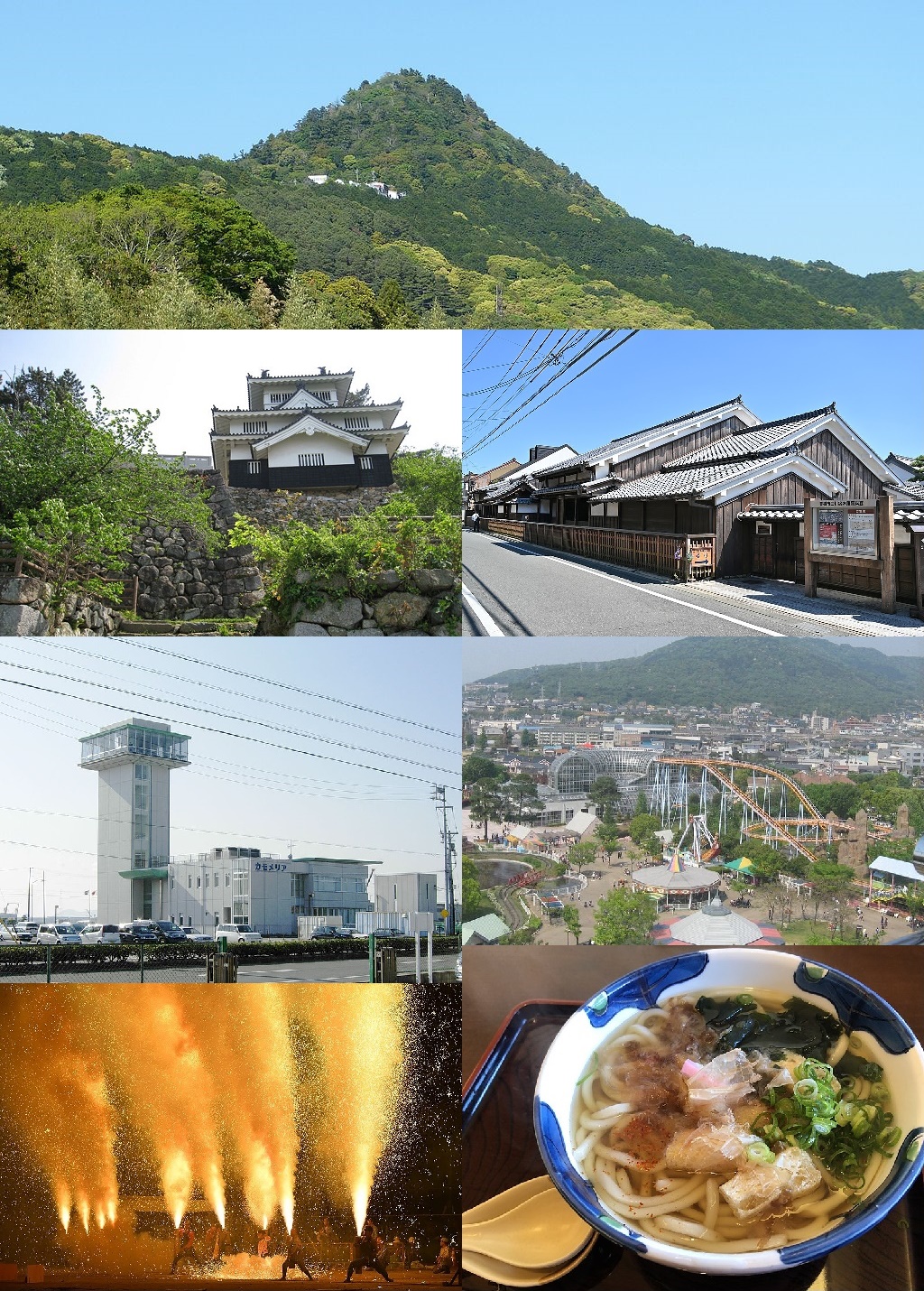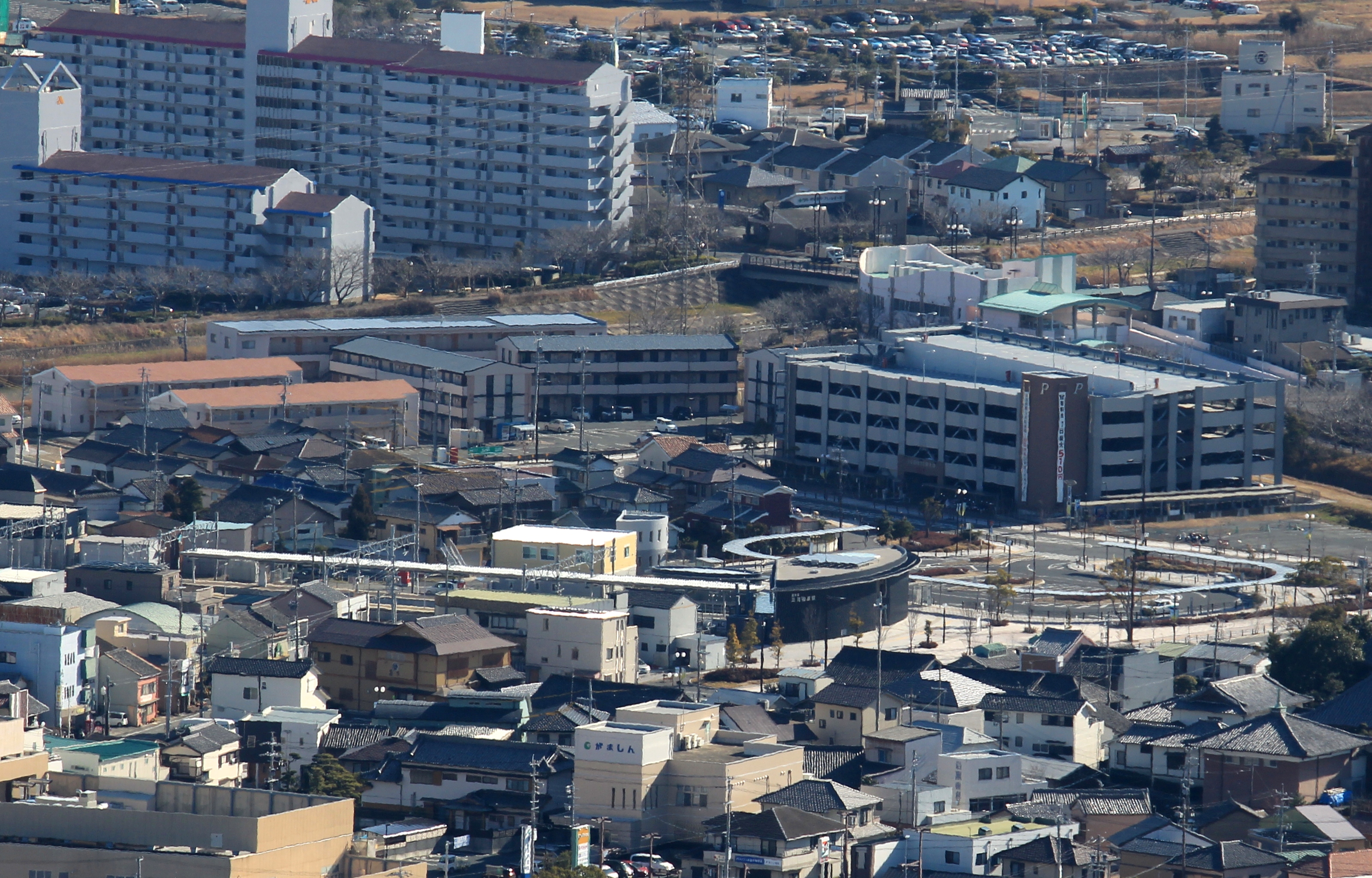|
Shin-Toyohashi Station
is a railway station in the city of Toyohashi, Aichi Prefecture, Japan, operated by the Public–private partnership Toyohashi Railroad. The station is physically adjacent to Toyohashi Station. Lines Shin-Toyohashi Station is a terminal station of the Atsumi Line, and is located 18.0 kilometers from the opposing terminus of the line at Mikawa-Tahara Station. Station layout The station has a single dead-headed island platform. The station is staffed. Adjacent stations , - !colspan=5, Toyohashi Railroad Station history Shin-Toyohashi Station was established by the privately-held Atsumi Railroad on October 1, 1927. Previously, the terminal of the Atsumi Railroad was 200 meters further north at . On September 1, 1940, the Atsumi Railway became part of the Nagoya Railway system, and was spun out again as the Toyohashi Railway on October 1, 1954. In 2008, the station was expanded, with its side platform changed to an island platform, and the station building replaced by an elev ... [...More Info...] [...Related Items...] OR: [Wikipedia] [Google] [Baidu] |
Toyohashi Railroad
The is a private railroad company in Japan, and a subsidiary of the Meitetsu Group. The company or its lines are commonly known as . The company operates the Atsumi Line train service on Atsumi Peninsula in Aichi Prefecture and a tram system in Toyohashi City, and has subsidiary operations involved in taxi and bus services. Company history The Toyohashi Railway was incorporated on March 17, 1924, as the , with its tram operations beginning on July 14, 1925. The company expanded into bus services from 1935. From September 1939, the company came under the umbrella of the Nagoya Railway (the forerunner to modern Meitetsu). The company established a subsidiary for taxicab operations on September 1, 1949. The company name was officially changed to its current name on July 22, 1954. On October 1, 1954, Meitetsu turned over operations and assets from its Atsumi Line to the new Toyohashi Railway Corporation. On October 1, 1956, the Toyohashi Railway acquired the local Taguchi Rail ... [...More Info...] [...Related Items...] OR: [Wikipedia] [Google] [Baidu] |
Toyohashi Railroad Atsumi Line
The is a railway line in eastern Aichi Prefecture, Japan, operated by the private railway operator Toyohashi Railroad ("Toyotetsu"). The line runs from the centre of Toyohashi, traversing the centre of the Atsumi Peninsula, a largely rural district noted also for its hot spring resorts and marine sports as part of Mikawa Wan Quasi-National Park. The line is entirely within the cities of Toyohashi and Tahara. Basic data * Line length: * Number of stations: 16 * Track: single * Rail gauge: * Electrification: 1,500 V DC overhead * Max speed: * Railway signalling: Automatic ( ATS, compatible with Meitetsu) Operation The northern terminal station for the Atsumi Line is located at Shin-Toyohashi Station. All trains run to the southern terminus at Mikawa Tahara Station at approximately 15 minute intervals. There are no express trains on the line. Station list Rolling stock , the line is operated using a fleet of ten three-car 1800 series electric multiple unit (EMU) trai ... [...More Info...] [...Related Items...] OR: [Wikipedia] [Google] [Baidu] |
Toyohashi
is a city in Aichi Prefecture, Japan. , the city had an estimated population of 377,453 in 160,516 households and a population density of 1,400 persons per km2. The total area of the city was . By area, Toyohashi was Aichi Prefecture's second-largest city until March 31, 2005 when it was surpassed by the city of Toyota, which had merged with six peripheral municipalities. Geography Toyohashi is located in southeastern Aichi Prefecture, and is the capital of the informal "Higashi-Mikawa Region" of the prefecture. It is bordered by Shizuoka Prefecture to the east, and by Mikawa Bay and the headlands of the Atsumi Peninsula to the west. To the south is the Enshu Bay of the Pacific Ocean. The presence of the warm Kuroshio Current offshore gives the city a temperate climate. The in Toyohashi is a sea turtle nesting spot. Climate The city has a climate characterized by hot and humid summers, and relatively mild winters (Köppen climate classification ''Cfa''). The average annual te ... [...More Info...] [...Related Items...] OR: [Wikipedia] [Google] [Baidu] |
Aichi Prefecture
is a prefecture of Japan located in the Chūbu region of Honshū. Aichi Prefecture has a population of 7,552,873 () and a geographic area of with a population density of . Aichi Prefecture borders Mie Prefecture to the west, Gifu Prefecture and Nagano Prefecture to the north, and Shizuoka Prefecture to the east. Overview Nagoya is the capital and largest city of Aichi Prefecture, and the fourth-largest city in Japan, with other major cities including Toyota, Okazaki, and Ichinomiya. Aichi Prefecture and Nagoya form the core of the Chūkyō metropolitan area, the third-largest metropolitan area in Japan and one of the largest metropolitan areas in the world. Aichi Prefecture is located on Japan's Pacific Ocean coast and forms part of the Tōkai region, a subregion of the Chūbu region and Kansai region. Aichi Prefecture is home to the Toyota Motor Corporation. Aichi Prefecture had many locations with the Higashiyama Zoo and Botanical Gardens, The Chubu Centrair Internat ... [...More Info...] [...Related Items...] OR: [Wikipedia] [Google] [Baidu] |
Public–private Partnership
A public–private partnership (PPP, 3P, or P3) is a long-term arrangement between a government and private sector institutions.Hodge, G. A and Greve, C. (2007), Public–Private Partnerships: An International Performance Review, Public Administration Review, 2007, Vol. 67(3), pp. 545–558 Typically, it involves private capital financing government projects and services up-front, and then drawing revenues from taxpayers and/or users over the course of the PPP contract. Public–private partnerships have been implemented in multiple countries and are primarily used for infrastructure projects. They have been employed for building, equipping, operating and maintaining schools, hospitals, transport systems, and water and sewerage systems. Cooperation between private actors, corporations and governments has existed since the inception of sovereign states, notably for the purpose of tax collection and colonization. However, contemporary "public-private partnerships" came into being ... [...More Info...] [...Related Items...] OR: [Wikipedia] [Google] [Baidu] |
Toyohashi Station
is an interchange railway station in Toyohashi, Aichi, Japan, operated by Central Japan Railway Company (JR Tōkai) and the private railway operator Nagoya Railroad (Meitetsu). Lines Toyohashi Station is served by the high-speed Tokaido Shinkansen, and the conventional Tokaido Main Line operated by JR Central. It is 293.6 kilometers from Tokyo Station. It is also the southern terminus of the Iida Line and is 129.3 kilometers form the northern terminus at Iida Station. The station is also a terminus for the 99.8 kilometer Meitetsu Nagoya Main Line. Toyohashi Railroad has two small stations close to Toyohashi Station: Shin-Toyohashi Station for the Atsumi Line railway and Ekimae Station for the Azumada Main Line tramway, but these stations are not physically connected to Toyohashi Station. Layout Local train services at Toyohashi Station are handled by five platforms serving eight tracks. The Iida Line and Meitetsu lines use three tracks terminating in a bay platform. T ... [...More Info...] [...Related Items...] OR: [Wikipedia] [Google] [Baidu] |
Mikawa-Tahara Station
is a railway station in the city of Tahara, Aichi Prefecture, Japan, operated by the Public–private partnership Toyohashi Railroad. Lines Mikawa Tahara Station is a terminal station of the Atsumi Line, and is located 18.0 kilometers from the opposing terminus of the line at Shin-Toyohashi Station. Station layout The station has two bay platforms, with an adjacent station building. The station building is staffed. Platforms Adjacent stations , - !colspan=5, Toyohashi Railroad Station history Mikawa Tahara Station was established on June 10, 1924 as on the privately-held Atsumi Railroad. The station name was changed to its present name in 1927. On April 10, 1926, the line was extended to Kurokawahara. The Atsumi Railroad was merged into the Nagoya Railroad on September 1, 1940. The section from Mikawa Tahara to Kurokawahara was discontinued on June 5, 1944. The Toyohashi Railroad Company was established on October 1, 1954. In October 1994, a new station building ... [...More Info...] [...Related Items...] OR: [Wikipedia] [Google] [Baidu] |
Island Platform
An island platform (also center platform, centre platform) is a station layout arrangement where a single platform is positioned between two tracks within a railway station, tram stop or transitway interchange. Island platforms are popular on twin-track routes due to pragmatic and cost reasons. They are also useful within larger stations where local and express services for the same direction of travel can be provided from opposite sides of the same platform thereby simplifying transfers between the two tracks. An alternative arrangement is to position side platforms on either side of the tracks. The historical use of island platforms depends greatly upon the location. In the United Kingdom the use of island platforms is relatively common when the railway line is in a cutting or raised on an embankment, as this makes it easier to provide access to the platform without walking across the tracks. Advantages and tradeoffs Island platforms are necessary for any station with many th ... [...More Info...] [...Related Items...] OR: [Wikipedia] [Google] [Baidu] |
Side Platform
A side platform (also known as a marginal platform or a single-face platform) is a platform positioned to the side of one or more railway tracks or guideways at a railway station, tram stop, or transitway. A station having dual side platforms, one for each direction of travel, is the basic design used for double-track railway lines (as opposed to, for instance, the island platform where a single platform lies between the tracks). Side platforms may result in a wider overall footprint for the station compared with an island platform where a single width of platform can be shared by riders using either track. In some stations, the two side platforms are connected by a footbridge running above and over the tracks. While a pair of side platforms is often provided on a dual-track line, a single side platform is usually sufficient for a single-track line. Layout Where the station is close to a level crossing (grade crossing) the platforms may either be on the same side of the cross ... [...More Info...] [...Related Items...] OR: [Wikipedia] [Google] [Baidu] |
List Of Railway Stations In Japan ...
The links below contain all of the 8579 railway stations in Japan. External links {{Portal bar, Japan, Trains * Railway stations Japan Japan ( ja, 日本, or , and formally , ''Nihonkoku'') is an island country in East Asia. It is situated in the northwest Pacific Ocean, and is bordered on the west by the Sea of Japan, while extending from the Sea of Okhotsk in the north ... [...More Info...] [...Related Items...] OR: [Wikipedia] [Google] [Baidu] |
Railway Stations In Aichi Prefecture
Rail transport (also known as train transport) is a means of transport that transfers passengers and goods on wheeled vehicles running on rails, which are incorporated in tracks. In contrast to road transport, where the vehicles run on a prepared flat surface, rail vehicles (rolling stock) are directionally guided by the tracks on which they run. Tracks usually consist of steel rails, installed on sleepers (ties) set in ballast, on which the rolling stock, usually fitted with metal wheels, moves. Other variations are also possible, such as "slab track", in which the rails are fastened to a concrete foundation resting on a prepared subsurface. Rolling stock in a rail transport system generally encounters lower frictional resistance than rubber-tyred road vehicles, so passenger and freight cars (carriages and wagons) can be coupled into longer trains. The operation is carried out by a railway company, providing transport between train stations or freight customer facilit ... [...More Info...] [...Related Items...] OR: [Wikipedia] [Google] [Baidu] |




